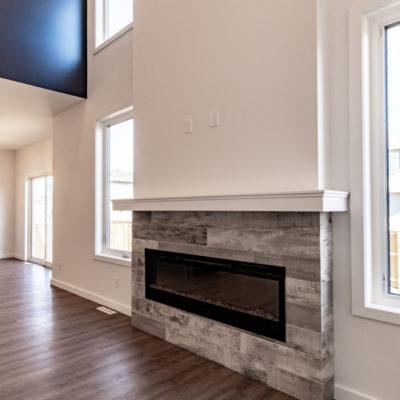“How much does it cost to build a home?”
This is one of the most common questions we receive – for good reason. The cost of a home is a critical factor in narrowing down your available options.
There are two perspectives when looking at the cost of building a new construction home. You can look at the costs from the purchaser’s side in terms of model costs, homesite costs, and extra inclusions to the home. You can also look at it in terms of land costs, building materials costs, and labor & overhead from the builder’s perspective.
Community and Homesite

Your choice of community, as well as your choice of homesite, are two key factors in the overall cost of your home.
The community you choose may have different architectural guidelines, as well as different foundation requirements both, of which change the price of the home. Some common architectural guidelines include front landscaping requirements, additional stone requirements, garage windows, and upgraded siding colors. If your homesite is backing a park or on a corner, the developer may require that there is additional window trim or a rear deck built.
The homesite that you choose will also change the overall price of the home. Homesite pricing is set by developers so depending on the community the same size of lot may be a different cost. As well, the width of the lot, proximity to amenities such as parks, and the lot features will all play a role. To view homesites, we have available visit our community pages.
Home Model
Perhaps the most obvious factor that affects the price of a new home is the model style. Starting prices for townhomes usually differ quite drastically from starting prices for a detached single-family home, for example. Deciding what type of home will meet your family’s needs is usually a good first step. Pacesetter Homes offers Townhomes, Duplexes in Saskatoon, Laned Homes in Regina and Front Attached Garage homes in both cities. Although Front Attached Homes are typically the most sought-after home type, many people will often opt for a detached garage home to allow more room in their budget for extra options.
Closely related to the home model factor, the size of the house and the floor plan will also influence pricing. Square footage is the key here. Typically, as square footage rises, so does the starting cost of the home.
While bedroom and bathroom count is often one of the first questions asked about a home, it’s less of an indicator of a home’s price than square footage. In many cases, homes with an additional bedroom or bathroom may be only slightly more expensive than homes without.
Extra Options
 Every new home comes with a variety of standard features that can be upgraded by the home buyer upon request. Pacesetter Homes has carefully chosen our standard features based on buyer’s wants and needs in Saskatchewan as well as optimizing for energy efficiency and home affordability. We also offer customized options for those looking to build their home from the ground up with us.
Every new home comes with a variety of standard features that can be upgraded by the home buyer upon request. Pacesetter Homes has carefully chosen our standard features based on buyer’s wants and needs in Saskatchewan as well as optimizing for energy efficiency and home affordability. We also offer customized options for those looking to build their home from the ground up with us.
Popular options include customizing interior door styles, adding under cabinet lighting, adding LVP to the second floor and adding a fireplace.
If you are looking to purchase a quick possession home there are still additional options for you including adding an appliance allowance to purchase your kitchen appliances and laundry using your mortgage. As well, we also offer back yard landscaping, deck building and basement completion services.
When adding most additional options to your home purchase Pacesetter Homes will give you what is called an allowance for this item. You will then select the specific item from the supplier and Pacesetter Homes will let you know the specific cost of that item. If what you have chosen is different than the amount of your allowance it will either be added or subtracted from the total cost of the home at closing. Say for example you have a lighting allowance of $2000. Once it came time to choose your interior light fixtures you would visit our lighting supplier’s showroom and pick the options that you would like. The lighting supplier would then provide Pacesetter Homes with your selection. If the cost of the lighting you chose was only $1500 then you would see a reduction of $500 on the home cost at closing.
Taxes and Rebates
 In Saskatchewan, both GST and PST are charged on new home construction. Pacesetter Homes factors both of these taxes along with their applicable rebates into the price of a new construction home. This way you aren’t left to figure out how to claim your GST or PST rebate after you move in – Pacesetter Homes has already accounted for that rebate upfront.
In Saskatchewan, both GST and PST are charged on new home construction. Pacesetter Homes factors both of these taxes along with their applicable rebates into the price of a new construction home. This way you aren’t left to figure out how to claim your GST or PST rebate after you move in – Pacesetter Homes has already accounted for that rebate upfront.
CMHC Green Home Rebate – This rebate is for any new construction home that meets the eligibility standards. For Pacesetter Homes we use a 3rd party company to test many of our homes to determine if they are 15% more energy efficient than a typical new home. If they are, the home purchaser will qualify for a rebate of 15% of their insurance premium. Insurance premiums are paid on any mortgage with less than 20% of a down payment.
Closing Costs
The term closing costs refers to a variety of different items. Some of the most common closing costs are:
-
- Legal Fees for Lawyers
-
- Land title charges and other disbursements paid through the lawyer’s office
-
- Home inspection
-
- Property appraisals
-
- Home/Fire Insurance
-
- Property Taxes
It’s hard to determine how much these things will cost until you get serious about buying your home. Speaking with your lawyer, mortgage specialist and insurance broker will be the best way to determine the exact amounts you will pay for closing costs. Property taxes are also handled a bit differently depending on the time of year that you take possession of the home and if the property taxes have been paid for the year. Either way, a pro-rated amount will be determined at closing.
Curious about what it would cost for your ideal home?
With a new construction home, you can choose what options you would like to add to your home making it all your own. Please fill out the form below and one of our area managers will be in touch with you.
